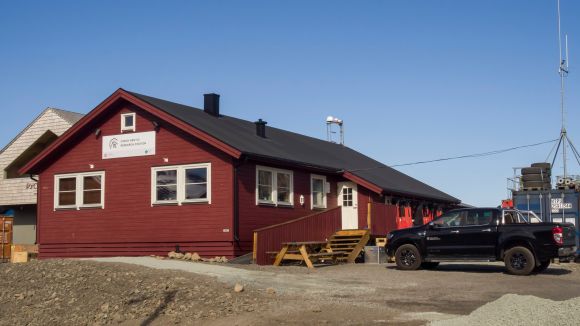CESNET services are also available on Svalbard (Spitsbergen) – the northernmost Czech research site
Prague, Svalbard, August 25th, 2022. Connectivity and related services of the optical infrastructure operated by CESNET, an association of Czech public universities and the Czech Academy of Sciences, are available in unusual places. They are used, for example, by scientists and students working on the Norwegian archipelago of Spitsbergen in the Arctic Ocean, specifically at the Czech Arctic Research Station of the University of South Bohemia in České Budějovice. CESNET has connected the station to the internet via the international academic network GÉANT and the Norwegian national e-infrastructure SIKT.
“We required a stable and secure connection to the scientific infrastructure,” says Jan Pechar, head of the Czech Arctic Research Station at the University of South Bohemia, “CESNET provided us with data connectivity via the GÉANT network. At the same time, it provides us with an access point based on the Czech Turris Omnia router. This connects the station to the eduroam international roaming network.” Czech and international academics and students working at the station can thus easily and securely connect to the Internet and can communicate and share data with research teams around the world.
The station is used by Czech and foreign scientists, for whom it provides support and scientific facilities for research on Svalbard. At the polar station, they study various fields: geology, botany, microbiology and others. They examine local living and non-living nature from different perspectives, including in relation to current global climate challenges. The outputs are flexibly implemented into the lectures for students, which are also provided here.
The first part of the implementation, the physical connection of the station to the international scientific infrastructure, was interesting from a technical, organisational and logistical point of view. The physical optical connection was carried out by CESNET in cooperation with The University Centre in Svalbard by laying optical fibre. Arrangements were made with the Norwegian national academic network SIKT and the international academic network GÉANT to provide connectivity using submarine optical fibre between the island and the mainland.
“In the next phase, which consisted of connecting the end users of the centre, we modified the configuration of a Turris Omnia router specially adapted to create an eduroam roaming point, remote supervision and monitoring,” says Radovan Igliar, CESNET’s deputy for services.
The device was installed at the station directly by its manager, Jan Pechar. However, the initial commissioning was not successful due to the attenuation of the optical fibers. The delivery of other optical transceivers was only possible within a few weeks. “We didn’t want to waste so much time, so we solved the problem by remote troubleshooting in cooperation with technicians from UNIS in Svalbard, the Norwegian SIKT network (UNINETT) in Trondheim, the European academic network GÉANT in Amsterdam and our technicians in Prague,” explains Radovan Igliar.
The CESNET association has long been striving for the widest possible network connection options for the scientific and academic community. Eduroam enables organizations and individuals to connect worldwide with a simple user authentication system.
CESNET was founded in 1996 by universities and the Academy of Sciences of the Czech Republic. Its aim is to operate and develop ICT services that form the national e-infrastructure for research, development, and education e-INFRA CZ. Research and development in the field of information and communication technologies are also an integral part of its activities. CESNET is an active partner in a number of foreign research infrastructures, such as the pan-European network for research, development, and education GÉANT, the European Grid Infrastructure EGI.eu, and the European Open Science Infrastructure EOSC. More at www.cesnet.cz, www. e-infra.cz.
Photo: source Czech Arctic Research Station





